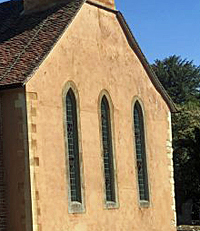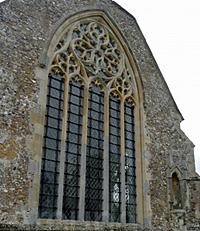
Most Anglican parish churches were built between 597 and 1530 in three main architectural styles: Saxon, Norman and Gothic. The second wave of Anglican church building did not begin until “the huge rise in population in the 19th century generated an explosion of church building." Essex has churches that rank in the top 100 of historic churches of England.

The oldest surviving Anglo-Saxon church [in England] is believed to be St Peter-on-the-Wall, at Bradwell-on-Sea, Essex. This church is said to have been built by the Saxon Bishop Cedd, around 654 AD. It sits astride the wall of a Roman fort and incorporates 'recycled' Roman building materials” (The Historic England Blog, Page, Robin, 8 February 2022). The chapel was restored and reconstructed in 1920. (Photograph by Reginald Clark. Source: Historic England Archive. Image reference: IOE01/08800/07.).
After Cedd died of the plague, St Peter’s became part of the Diocese of London and completely disappeared from church records until the 1400s. In its long history, the church has survived fires, King Henry VIII’s dissolution of the monasteries, being used as a cowshed by resourceful locals, and heavy bombing in the area during World War II” (Chapel of St Peter on the Wall. Edited by Collins Connor, Atlas Obscura, 20 Mach 2020).
St Peter-on-the-Wall has features characteristic of the Saxon style, including tall entryways, herringbone brick pattern, and an arched window about the main door. The walls are not as thick as Norman construction.

The first impression of Norman architecture is its castle-like appearance. You can identify Essex churches built during the Norman period by their recessed doorways, which is a feature due to thick, deep walls. Norman churches with square towers can be seen all over Essex.
A celebrated Norman Church is St Michael and All Angels of Copford, Essex, which was originally dedicated as St Mary and then rededicated after completing its restoration in 1884. “The original Norman building had a barrel vaulted nave, an exceptionally rare example in England that was replaced by the present timber structure in about 1400…[Moreover, the bricks are] one of the earliest examples in England of locally made medieval bricks” (National Trust Brochure).
A ancient and wonderful feature is its apse which still has “its original Norman vault.” The church’s magnificent medieval frescoes were discovered under a 16h whitewash (picture by National Churches Trust). “The paintings show a strong Byzantine influence in content and design (National Trust Brochure). “The artist is thought to be Master Hugo, who worked at Bury St Edmunds in the 1130s (Britain Express attraction guide).
The Gothic Style originated in France. In England, the style went through three iterations: Early, Decorative and Perpendicular. Compared with Norman styhle, Gothic structures look more like a home than a castle, although a house that is highly decorated, has good security, and has large windows. Gothic style by its use of light, rounded arches, and vertical lines.
Maruice FitzGeoffery established an Abbey at Tilty in 1153. "The first monks at Tilty came from Warden Abbey, Bedfordshire, which in turn had been founded by monks from the famous Cistercian abbey at Rievaulx in Yorkshire...The abbey was a complex of buildings based around a typical Cistercian plan, including a church, cloisters, refectory, and living quarters [although little of the Abby remans]…The church [today] is an odd building; with a 14th-century chancel and Georgian nave joined as if pieces of two different churches had been randomly stuck together" (Britain Express Travel Guide).
St John of Thaxed was “built between 1340 and 1510, is renowned for its flying-buttressed spire, which is 181 feet tall and is the only medieval stone spire in Essex (photograph byStephen McKay, CC BY-SA 2.0, https://commons.wikimedia.org/w/index.php? curid=9273591. It has perpendicular windows and a stained-glass representing Adam and Eve… It is a typical ‘wool church’, built with the proceeds from England's medieval wool trade” (Richardson, Baz, photographer on Flickr, 11 July 2012). St Mary of Saffron is another example of the Perpendicular style.

St Mary and Abby of Tilty.

St Mary and Abby of Tilty.

St John of Thaxted
We do not know what you know. Please share with us your knowledge, and help us correct any error you find in our research.